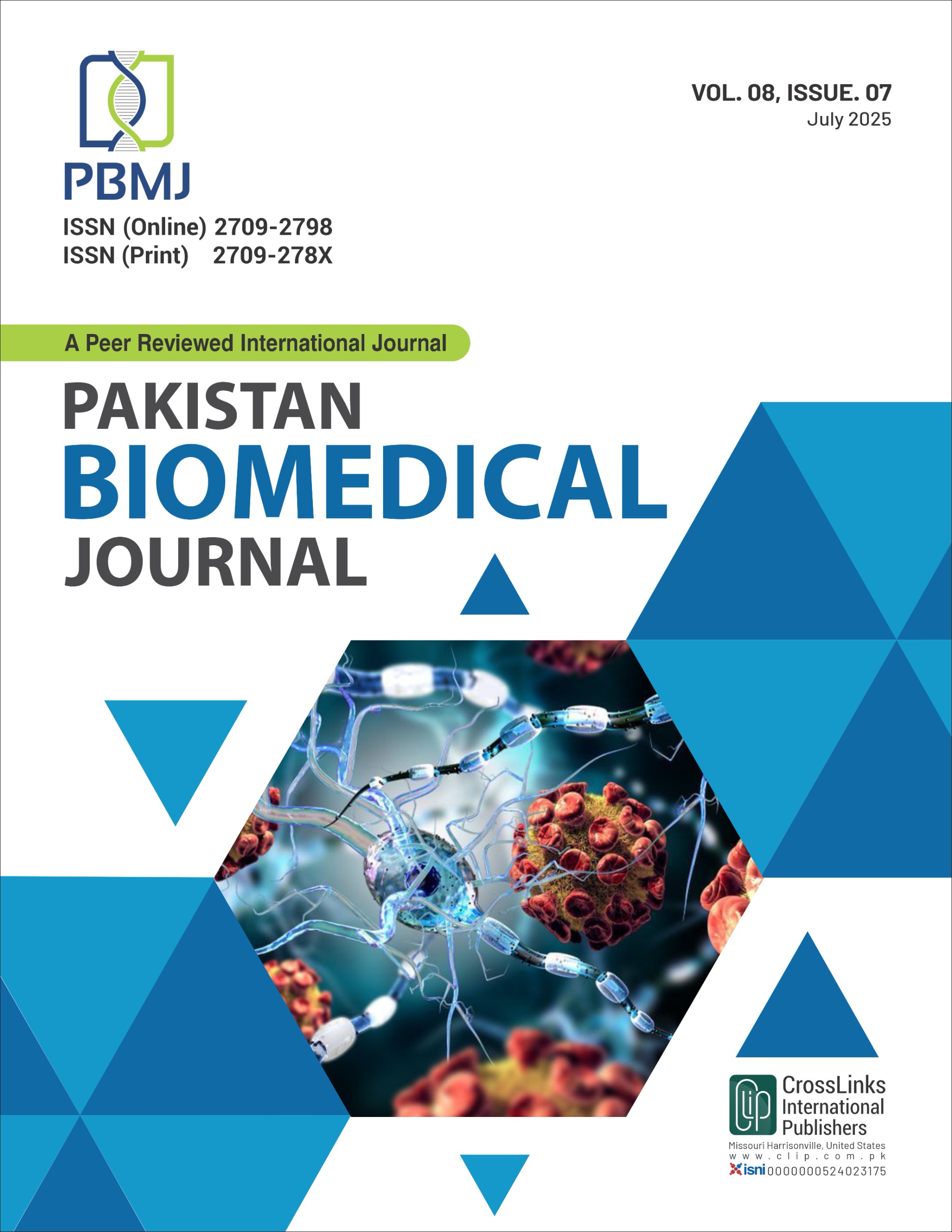Microbial Contamination of Healthcare Personnel and Devices: A Critical Route for Pathogen Transmission
Microbial Contamination of Healthcare Personnel and Devices for Pathogen Transmission
DOI:
https://doi.org/10.54393/pbmj.v8i7.1314Keywords:
Antibiotic Resistance, Bacterial Isolation, Medical Staff, Microbial Interaction, Microbial ContaminationAbstract
Since healthcare workers are often exposed to pathogenic organisms, they can unintentionally transfer disease to patients, causing healthcare-associated infections (HAIs). Objectives: To isolate healthcare staff and their respective equipment to determine the level of contamination and the pattern of antibiotic resistance. Methods: A total of 153 samples were taken out of doctors (n=52), nurses (n=44), lab technicians (n=33), and ward boys (n=24) in Nishtar Hospital, Multan, in this cross-sectional study that was based on laboratory procedures. Hands, stethoscopes, and mobile phones were taken, cultured on selective medium, and identified to the level of genus. Antibiotic susceptibility was evaluated using the Kirby–Bauer disc diffusion method against piperacillin (100 µg), ciprofloxacin (5 µg), levofloxacin (5 µg), gentamicin (10 µg), and imipenem (10 µg). Data were analyzed using ANOVA at a 95% confidence level. Results: Out of 153 samples, 93 (60.13%) yielded positive bacterial cultures. The highest number of positive cultures was recorded among lab technicians (63.64%), followed by ward boys (62.50%), doctors (57.69%), and nursing staff (56.82%) (p<0.05). The most frequently isolated bacteria were Bacillus sp. (22.58%), Enterococcus sp. (19.35%), and Escherichia sp. (17.20%). Mobile phones (45.16%) showed the highest contamination, followed by hands (37.63%) and stethoscopes (35.48%). All Enterococcus isolates were 100% resistant to Piperacillin, while all Staphylococcus and Klebsiella isolates showed complete resistance to multiple antibiotics. Conclusions: Healthcare personnel and their commonly used devices act as reservoirs for multidrug-resistant bacteria. Strict adherence to infection control protocols and specialized training for healthcare staff are essential to minimize cross-contamination and prevent HAIs.
References
Nepomuceno DB, Lima DV, Silva MO, Porto JC, Mobin M. Evaluation of Disinfectants to Eliminate Fungal Contamination in Computer Keyboards of an Integrated Health Center in Piauí, Brazil. Environmental Monitoring and Assessment. 2018 Oct; 190(10): 608. doi: 10.1007/s10661-018-6987-6. DOI: https://doi.org/10.1007/s10661-018-6987-6
Qasemi M, Shams M, Sajjadi SA, Farhang M, Erfanpoor S, Yousefi M et al. Cadmium in Groundwater Consumed in the Rural Areas of Gonabad and Bajestan, Iran: Occurrence and Health Risk Assessment. Biological Trace Element Research. 2019 Dec; 192(2): 106-15. doi: 10.1007/s12011-019-1660-7. DOI: https://doi.org/10.1007/s12011-019-1660-7
Ghaderpoori M, Paydar M, Zarei A, Alidadi H, Najafpoor AA, Gohary AH et al. Health Risk Assessment of Fluoride in Water Distribution Network of Mashhad, Iran. Human and Ecological Risk Assessment: An International Journal. 2019 May; 25(4): 851-62. doi: 10.1080/10807039.2018.1453297. DOI: https://doi.org/10.1080/10807039.2018.1453297
Saleh HN, Kavosi A, Pakdel M, Yousefi M, Asghari FB, Mohammadi AA. Assessment Health Status of ICU Medical Equipment Levels at Neyshabur Hospitals Using ICNA and ACC Indices. MethodsX. 2018 Jan; 5: 1364-72. doi: 10.1016/j.mex.2018.10.016. DOI: https://doi.org/10.1016/j.mex.2018.10.016
Yousefi M, Saleh HN, Yaseri M, Mahvi AH, Soleimani H, Saeedi Z et al. Data on Microbiological Quality Assessment of Rural Drinking Water Supplies in Poldasht County. Data in Brief. 2018 Apr; 17: 763-9. doi: 10.1016/j.dib.2018.02.003. DOI: https://doi.org/10.1016/j.dib.2018.02.003
Russotto V, Cortegiani A, Raineri SM, Giarratano A. Bacterial Contamination of Inanimate Surfaces and Equipment in the Intensive Care Unit. Journal of Intensive Care. 2015 Dec; 3(1): 54. doi: 10.1186/s40560-015-0120-5. DOI: https://doi.org/10.1186/s40560-015-0120-5
Sebola DC, Oguttu JW, Kock MM, Qekwana DN. Hospital-Acquired and Zoonotic Bacteria from A Veterinary Hospital and Their Associated Antimicrobial-Susceptibility Profiles: A Systematic Review. Frontiers In Veterinary Science. 2023 Jan; 9: 1087052. doi: 10.3389/fvets.2022.1087052. DOI: https://doi.org/10.3389/fvets.2022.1087052
Okey-kalu EU and Nwankwo EO. Bacterial Contamination of Intensive Care Units at a Federal Medical Centre in Abia State, Nigeria. Suan Sunandha Science and Technology Journal. 2022 Nov; 9(1): 25-35.
Blot S, Ruppé E, Harbarth S, Asehnoune K, Poulakou G, Luyt CE et al. Healthcare-Associated Infections in Adult Intensive Care Unit Patients: Changes in Epidemiology, Diagnosis, Prevention and Contributions of New Technologies. Intensive and Critical Care Nursing. 2022 Jun; 70: 103227. doi: 10.1016/j.iccn.2022.103227. DOI: https://doi.org/10.1016/j.iccn.2022.103227
Ababneh Q, Abulaila S, Jaradat Z. Isolation of Extensively Drug Resistant Acinetobacter Baumannii from Environmental Surfaces Inside Intensive Care Units. American Journal of Infection Control. 2022 Feb; 50(2): 159-65. doi: 10.1016/j.ajic.2021.09.001. DOI: https://doi.org/10.1016/j.ajic.2021.09.001
Tusabe F, Kesande M, Amir A, Iannone O, Ayebare RR, Nanyondo J. Bacterial Contamination of Healthcare Worker’s Mobile Phones: A Case Study at Two Referral Hospitals in Uganda. Global Security: Health, Science and Policy. 2022 Dec; 7(1): 1-6. doi: 10.1080/23779497.2021.2023321. DOI: https://doi.org/10.1080/23779497.2021.2023321
Wei C, Li CZ, Löschel A, Managi S, Lundgren T. Digital Technology and Energy Sustainability: Recent Advances, Challenges, and Opportunities. Resources, Conservation and Recycling. 2023 Mar; 190: 106803. doi: 10.1016/j.resconrec.2022.106803. DOI: https://doi.org/10.1016/j.resconrec.2022.106803
Jaber AS, Juma HA, Aliwi AA. Isolation of Pathogenic Bacteria from Equipment of the Care Units, Hands and Mobile Devices for Medical Staff in Educational Al-Hussein Hospital. Pakistan Journal of Medical and Health Sciences. 2023 Feb; 17: 484–. doi: 10.53350/pjmhs2023172484. DOI: https://doi.org/10.53350/pjmhs2023172484
Liaqat I, Muhammad N, Mubin M, Arshad N, Iftikhar T, Sajjad S et al. Antibacterial and Larvicidal Activity of Ethyl Acetate Extract of Actinomycetes from Soil Samples. Pakistan Journal of Zoology. 2023 Oct; 55(6): 2065-74. doi: 10.17582/journal.pjz/20200526130518. DOI: https://doi.org/10.17582/journal.pjz/20200526130518
Bodena D, Teklemariam Z, Balakrishnan S, Tesfa T. Bacterial Contamination of Mobile Phones of Health Professionals in Eastern Ethiopia: Antimicrobial Susceptibility and Associated Factors. Tropical Medicine And Health. 2019 Feb; 47(1): 15. doi: 10.1186/s41182-019-0144-y. DOI: https://doi.org/10.1186/s41182-019-0144-y
Araya S, Desta K, Woldeamanuel Y. Extended-Spectrum Beta-Lactamase-Producing Gram-Negative Bacteria on Healthcare Workers’ Mobile Phones: Evidence from Tikur Anbessa Specialized Hospital, Addis Ababa, Ethiopia. Risk Management and Healthcare Policy. 2021 Jan: 283-91. doi: 10.2147/RMHP.S291876. DOI: https://doi.org/10.2147/RMHP.S291876
Abid S, Farid A, Abid R, Rehman MU, Alsanie WF, Alhomrani M et al. Identification, Biochemical Characterization, and Safety Attributes of Locally Isolated Lactobacillus Fermentum from Bubalus Bubalis (Buffalo) Milk as A Probiotic. Microorganisms. 2022 Apr; 10(5): 954. doi: 10.3390/microorganisms10050954. DOI: https://doi.org/10.3390/microorganisms10050954
Liaqat I, Muhammad N, Ara C, Hanif U, Andleeb S, Arshad M et al. Bioremediation of Heavy Metals Polluted Environment and Decolourization of Black Liquor Using Microbial Biofilms. Molecular Biology Reports. 2023 May; 50(5): 3985-97. doi: 10.1007/s11033-023-08334-3. DOI: https://doi.org/10.1007/s11033-023-08334-3
Dalton KR, Rock C, Carroll KC, Davis MF. One Health in Hospitals: How Understanding the Dynamics of People, Animals, and the Hospital Built-Environment Can Be Used to Better Inform Interventions for Antimicrobial-Resistant Gram-Positive Infections. Antimicrobial Resistance and Infection Control. 2020 Jun; 9(1): 78. doi: 10.1186/s13756-020-00737-2. DOI: https://doi.org/10.1186/s13756-020-00737-2
Pace MC, Corrente A, Passavanti MB, Sansone P, Petrou S, Leone S et al. Burden of Severe Infections Due to Carbapenem-Resistant Pathogens in Intensive Care Unit. World Journal of Clinical Cases. 2023 May; 11(13): 2874. doi: 10.12998/wjcc.v11.i13.2874. DOI: https://doi.org/10.12998/wjcc.v11.i13.2874
Fracarolli IF, Watanabe E, Oliveira VD, Machado MB, Bim FL, Bim LL et al. The Implications of Healthcare Professionals Wearing Jewelry on Patient Care Biosafety: Observational Insights and Experimental Approaches. Scientific Reports. 2024 Aug; 14(1): 18601. doi: 10.1038/s41598-024-69711-x. DOI: https://doi.org/10.1038/s41598-024-69711-x
Rao DA, Aman A, Muhammad Mubeen S, Shah A. Bacterial Contamination and Stethoscope Disinfection Practices: A Cross-Sectional Survey of Healthcare Workers in Karachi, Pakistan. Tropical Doctor. 2017 Jul; 47(3): 226-30. doi: 10.1177/0049475516686543. DOI: https://doi.org/10.1177/0049475516686543
Kindie S, Mengistu G, Kassahun M, Admasu A, Dilnessa T. Bacterial Profile and Antimicrobial Susceptibility Patterns of Isolates from Inanimate Objects Used by Healthcare Professionals at Debre Markos Comprehensive Specialized Hospital, Northwest Ethiopia. PLOS One. 2024 Nov; 19(11): e0313474. doi: 10.1371/journal.pone.0313474. DOI: https://doi.org/10.1371/journal.pone.0313474
Mushabati NA, Samutela MT, Yamba K, Ngulube J, Nakazwe R, Nkhoma P et al. Bacterial Contamination of Mobile Phones of Healthcare Workers at the University Teaching Hospital, Lusaka, Zambia. Infection Prevention in Practice. 2021 Jun; 3(2): 100126. doi: 10.1016/j.infpip.2021.100126. DOI: https://doi.org/10.1016/j.infpip.2021.100126
Mshelia MB, Zenoh DA, Fasogbon IV, Micheal NY, Obi C, Adam M et al. Antibacterial Resistance Genes Frequently Detected in Nigeria. African Journal of Biomedical Research. 2024 Sep; 27(2): 225-41.
Dhayhi N, Kameli N, Salawi M, Shajri A, Basode VK, Algaissi A et al. Bacterial Contamination of Mobile Phones Used by Healthcare Workers in Critical Care Units: A Cross-Sectional Study from Saudi Arabia. Microorganisms. 2023 Aug; 11(8): 1986. doi: 10.3390/microorganisms11081986. DOI: https://doi.org/10.3390/microorganisms11081986
Chang F, Wang X, Huang X, Liu X, Huang L. Analysis on Bacterial Distribution and Change of Drug Resistance Rate in ICUs Across Southwest China from 2018 to 2022. Infection and Drug Resistance. 2023 Dec: 5685-96. doi: 10.2147/IDR.S421357. DOI: https://doi.org/10.2147/IDR.S421357
Khan A, Miller WR, Axell-House D, Munita JM, Arias CA. Antimicrobial Susceptibility Testing for Enterococci. Journal of Clinical Microbiology. 2022 Sep; 60(9): e00843-21. doi: 10.1128/jcm.00843-21. DOI: https://doi.org/10.1128/jcm.00843-21
Pulingam T, Parumasivam T, Gazzali AM, Sulaiman AM, Chee JY, Lakshmanan M et al. Antimicrobial Resistance: Prevalence, Economic Burden, Mechanisms of Resistance and Strategies to Overcome. European Journal of Pharmaceutical Sciences. 2022 Mar; 170: 106103. doi: 10.1016/j.ejps.2021.106103. DOI: https://doi.org/10.1016/j.ejps.2021.106103
Downloads
Published
How to Cite
Issue
Section
License
Copyright (c) 2025 Pakistan BioMedical Journal

This work is licensed under a Creative Commons Attribution 4.0 International License.
This is an open-access journal and all the published articles / items are distributed under the terms of the Creative Commons Attribution License, which permits unrestricted use, distribution, and reproduction in any medium, provided the original author and source are credited. For comments editor@pakistanbmj.com











